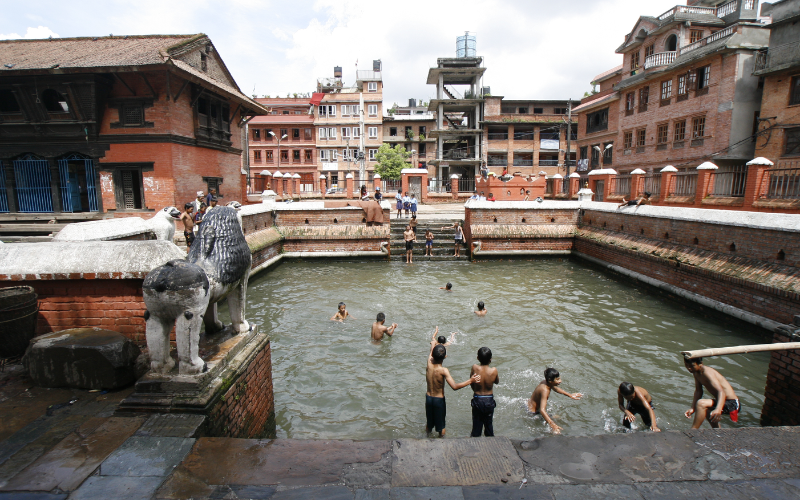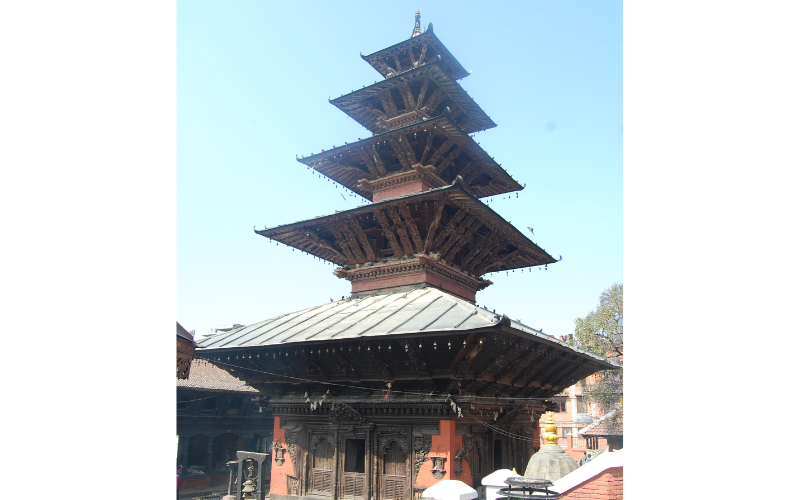Nestled just north of Patan Durbar Square in the Kathmandu Valley, Kumbheshwor Temple is one of the oldest and most revered Hindu shrines in Patan (Lalitpur), Nepal. Renowned for its striking five-storeyed pagoda design and rich cultural heritage, it stands as a testament to centuries of devotion and artistry.
Historical Background
The temple was originally commissioned around 1392 A.D. by King Jayasthiti Malla. Initially constructed with two storeys, it was later expanded in the 17th century by King Srinivasa Malla, who added the upper three tiers to create the distinctive five-storeyed structure seen today. This architectural evolution reflects the craftsmanship and religious devotion of the Malla period.
Architectural Features
Kumbheshwor Temple is a fine example of Newar pagoda architecture, celebrated for its intricate woodcarvings and ornate struts. The temple’s façade is adorned with detailed depictions of Hindu deities and mythological motifs, while a large stone Nandi (bull) faces the main shrine, symbolising Lord Shiva’s mount.
The complex also contains smaller shrines, courtyards, and hiti ponds, which contribute to the temple’s serene atmosphere. The combination of artistic detail and harmonious proportions exemplifies the pinnacle of Newar craftsmanship.

Sacred Pond and Spiritual Significance
Within the temple grounds are two sacred ponds, fed by a natural spring believed to be connected to the holy Gosaikunda Lake in the Himalayas. Local tradition holds that bathing in these ponds, particularly during Janai Purnima, is equivalent to a pilgrimage to Gosaikunda itself. This belief makes the temple an important site of ritual purification and spiritual reflection.
Festivals and Devotion
Kumbheshwor Temple is dedicated to Lord Shiva and plays a central role in several Hindu festivals. Janai Purnima is the most prominent, drawing thousands of devotees who perform ritual bathing and renew their sacred threads. Other celebrations, such as Shivaratri, Teej, and Bala Chaturdashi, also attract worshippers from across the Kathmandu Valley.
Other Shrines Within the Complex
The temple complex houses several additional shrines, including those dedicated to Bagalamukhi, Ulmanta Bhairava, Harati, Manakamana, and Badrinath. Each shrine has its own rituals and significance, creating a rich tapestry of devotion within the site.

Cultural and Legendary Significance
Local legends tell of a leprous farmer who discovered the healing spring within the temple grounds and was miraculously cured. The king, impressed by this event, renamed him Lalit, a story which is believed to have contributed to the naming of Lalitpur. Alternative folklore links the temple’s name to a sacred water vessel or the connection to Gosaikunda, highlighting the temple’s longstanding spiritual importance.
Today, Kumbheshwor Temple remains a living centre of worship and cultural heritage. Its combination of architectural brilliance, sacred water sources, and historical significance makes it a must-visit for tourists and devotees alike. Visitors can explore the temple’s intricate carvings, witness traditional rituals, and experience a sense of tranquillity amidst the vibrant surroundings of Patan.
PC:Suraj Belbase, Wikimedia Commons
Also Read